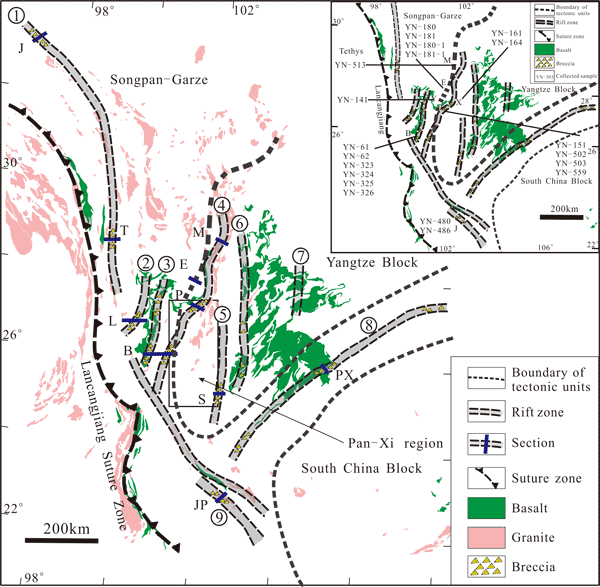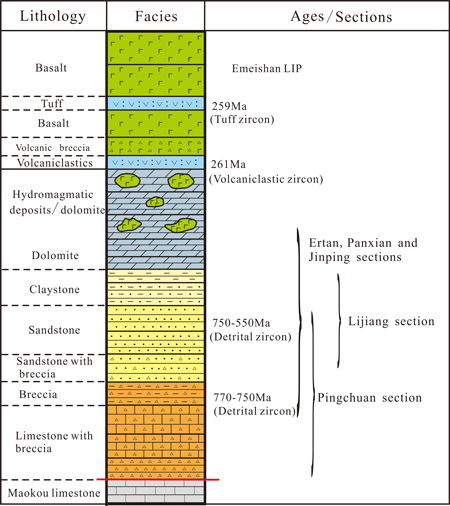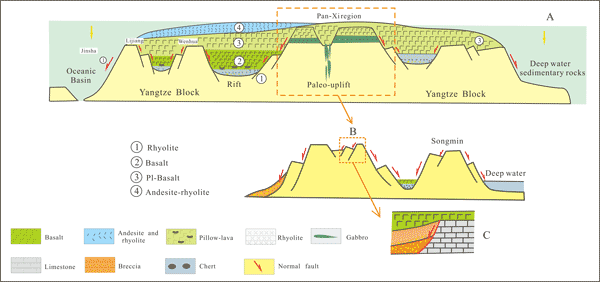 |
Rifting in SW China: initial crustal response to emplacement of the Permian Emeishan LIP |
Yu Wang1, Ingrid Ukstins Peate2, Zhaohua Luo1, Shuzhi Wang1, Lilu Cheng3, Jinhua Hao1 & Ye Wang1
1Institute of Earth Sciences, China University of Geosciences, Beijing 100083, China; wangy@cugb.edu.cn ; luozh@cugb.edu.cn ; wangszh1987@163.com ; haojh@cugb.edu.cn ; wangyeye1010@163.com
2Earth and Environmental Sciences, 115 Trowbridge Hall, University of Iowa, Iowa City, Iowa 52242, USA; ingrid-peate@uiowa.edu
3Earth Observatory of Singapore, 50 Nanyang Avenue, Singapore 639798, Singapore; llcheng@ntu.edu.sg
Abstract
A rift system developed prior to the main stage of flood basalt eruptions of the Middle-Late Permian Emeishan large igneous province. The rifting progressed in pulses, with an initial phase of normal faulting followed by rapid deposition of breccias and clastic sedimentary deposits. Later there was lower-energy deposition of sandstone, mudstones and dolomites with accompanying hydromagmatic deposits and rhyolitic eruptions. Rift system formation was influenced by a combination of far- and near-field tectonic stresses due to plate motions and lithospheric interaction with Emeishan magmatism.
Introduction
The response of the lithosphere prior to the onset of flood volcanism is much debated. The tectonic setting of volcanic eruptions, e.g., the continental interior or margin, is an important factor. Magma sometimes passes through thick lithosphere before erupting. The influence of near-field stress resulting from the upwelling of the magma itself has been emphasized in mantle plume models (e.g., Campbell, 2005) and rift system settings (e.g., Ziegler & Cloetingh, 2004).
The Emeishan flood basalt formed during the Middle to Late Permian. It covers 250,000 km2 and is distributed in the western Yangtze Block and along its southeastern margin (Figure 1). Prior to eruption there was a long-lived, stable, shallow continental sea which had existed since the late Proterozoic. It has been proposed that eruption of the Emeishan flood basalt was associated with ca. 1 km of pre-volcanic domal uplift providing evidence for a mantle plume source (He et al., 2003). However, several authors have disputed this claim (e.g., Ukstins Peate & Bryan, 2008; Wang et al., 2014; Jerram et al., 2016).

Figure 1. Distribution of rift zones in the Yangtze Block and surroundings. Circled numbers indicate rift zones as follows: 1 = Jinsha, 2 = Lijiang-Wenhuae, 3–4 = Binchuan-Pingchuane, 4 = Ertane, 5 = Songming, 6=Qiaojia, 7=Hezhang, 8=Panxian, 9=Jinping. Capital letters show the positions of the detailed cross-sections: T – Tuoding, J – Jinsha, M – Muli, E – Ertan, B – Binchuan, P – Pingchuan, S – Songming, JP – Jinping, PX – Panxian. The current configuration of the rifts is shown. Inset shows sites sampled for sandstone, tuff, gabbro and pegmatite. Capital letters show locations of the samples presented in this study. Click here or on Figure for enlargement.
Regional distribution and features of the NS-trending rift zones
Widespread rift features have been identified by detailed field studies (Figure 1). The rifts contain significantly thicker lava successions than the outlying areas and variable sedimentation suggesting accommodation space and deeper-marine environments with inter-trappean sediments. These extensional structures represent the deformation of the continental lithosphere of the Yangtze Block prior to the emplacement of the Emeishan LIP in the Middle to Late Permian. Along the western side of the Pan-Xi palaeo-uplift, grabens are NS-trending, but on the southeastern side of the Yangtze Block, the Panxian-Wujiang zone trends NE-SW. Gabbro dykes and ultramafic sheets, common in the Pan-Xi region, run parallel to rift system faults. Many of these intrusive bodies cut the Middle Permian Maokou Formation, and appear to be emplaced along faults.
Based on detailed field stratigraphy, structural features and detrital zircon geochronology, a composite section has been compiled from eight detailed stratigraphic profiles representing rift basin stratigraphy immediately beneath the Emeishan basalts through to the Maokou Formation (Figure 2). Local erosion and deposition along rift basin margins have formed angular, carbonate-bearing breccias from local lithologies. These deposits fine up-section, transitioning to silicate-bearing sandstones and mudstones. Dolomite deposition re-establishes itself, and the influence of magmatism begins to be observed with the occurrence of hydromagmatic and volcaniclastic deposits.

Figure 2: Composite stratigraphic section from detailed field stratigraphy, structural features and detrital zircon geochronology at eight locations representing rift basin stratigraphy immediately beneath the Emeishan basalts through to the Maokou Formation.
Eruption was through the active carbonate platform and pyroclastic deposits which immediately precede, and are intercalated with, the lowermost Emeishan basalt lavas. The Maokou Formation is cut by faults and has different thicknesses on either side of the fault zones, such as along the Qiaojia-Songming zone and in the west of the Pingchuan area. In some places, there are ~ 50-200 m differences in the thickness of the Maokou Formation on either side of a fault. In the hanging walls of both fault zones deep-water siliceous sediments such as chert can be found. This is an important constraint on the initiation of the rift system and indicates that normal faulting did not take place after the Maokou Formation but was contemporaneous with its deposition. The deposition of the Maokou Formation was associated with the rifting, and the composite structural/sedimentary/volcanic section provides a detailed record of the activity (Figure 2).
Emeishan rift system evolution
In the study area, zircon ages from gabbros and pegmatites give the timing of volcanic activity. These events occurred at 260-264 Ma (±2% errors), and they constrain the onset of extension. The ages of the volcanic deposits that constrain the timing of rifting pre-date ~259 Ma, i.e. they are prior to the basaltic eruptions. The dominant peak in detrital zircon ages of the clastic deposits is 700-850 Ma (Figure 2). These ages are typical of those found in adjacent basement rocks of the Yangtze Block (e.g., Zhou et al., 2002) and indicate derivation from nearby basement rocks during transport and deposition in the rift system. These sandstones formed during the period of normal faulting that marked the end of deposition of the Permian Maokou Formation shallow platform carbonates, and took place before the main phase of basaltic eruptions. They were characterized by rapid deposition, short transport distances and fining-upward sequences which record a change from a single to multiple sources up-section.
Sandstone deposition, which records erosion of old crustal materials and near-source infilling of the developing rift systems, took place prior to mafic volcanism in the Emeishan. Depositional sequences within rift basins follow the pattern of:
- initiation of faulting and brecciation;
- deposition of basal sandstones and breccias, fining upwards;
- mudstone or dolomite deposition;
- hydromagmatic eruptions through shallow carbonate platform environments; and
- emplacement of basaltic lavas and pillow lavas with associated tephra deposits.
The region was already tectonically active prior to the initiation of volcanism, and rifting and lithospheric fracturing were likely aided by channeling of the upwelling magma (Figure 3). Palaeobiological observations suggest that the initial stage of activity lasted at least 3-5 Ma (Isozaki et al., 2007). Furthermore, there is evidence that pre-volcanic rifting may have progressed sporadically. The variability of clastic sedimentation and cyclicity of coarse clastic deposits transitioning to mudstones and dolomites may reflect slowing of deposition. In addition, the lower Maokou Formation shows the effects of syn-depositional faulting in different thicknesses of the formation on either side of rift zones. This feature is only evident along the rift system itself, such as along the eastern marginal fault of the Pan-Xi region, as well as along the boundary between the Yangtze Block and South China Block. There are also high-Ti basalts in the middle-late parts of the volcanic sequence (Xiao et al., 2004) in all the LIP areas, but low-Ti basalts only occur in the lower section of the Binchuan rift zone (Xiao et al., 2004). This contrasts with the mantle-plume uplift model, which predicts that low-Ti basalts should be found in the core of the uplift and high-Ti basalts in the outer zone.

Figure 3. Summary cross-section of the region from west to east showing the response to the four stages of volcanic eruption in the region. The inset diagrams show the main two kinds of deformation and the uplift due to faulting in the area. Click here or on Figure for enlargement.
The overall pattern of events involving normal faulting, the channeling of magma along tectonic pathways, eruption of voluminous basaltic flood lavas, and accompanying crustal depression and sedimentation, together built an intracontinental rift system. We infer that the initial crustal response to emplacement of the Emeishan LIP was:
-
Rift system formation was not continuous and progressed as pulses. Large-scale faults would have acted as channels along which magma could ascend rapidly.
-
The regional response to initiation of volcanism was transgressive: from the margins to the interior of the Yangtze Block (Figure 1). Most of the rift zones are presently oriented NS and probably reflect an overall EW extension affecting the South China craton at this time, although the rifts on the west and southeast sides have variable orientations suggesting differences in timing and geodynamic setting.
-
Detailed stratigraphic and palaeobiologic evidence shows that rifting initiated ~5 Ma prior to LIP emplacement. Pre-volcanic tectonic development was thus dominated by large-scale rift systems and extensional faulting (Figure 3).
References
-
Campbell, I.H. 2005. Large igneous provinces and the mantle plume hypothesis. Elements 1, 265–9.
-
He, B., Xu, Y.G., Chung, S.L. & Wang, Y. 2003. Sedimentary evidence for a rapid crustal doming before the eruption of the Emeishan flood basalts. Earth and Planetary Science Letters 213, 389–403.
-
Isozaki, Y., Kawahata, H. & Minoshima, K. 2007. The Capitanian (Permian) Kamura cooling event: the beginning of the Paleozoic–Mesozoic transition. Palaeoworld 16, 16–30.
-
Jerram, D.A., Widdowson, M., Wignall, P.B., Sun, Y.D., Lai, X.Y., Bond, D.P.G. & Torsvik, T.H. 2016. Submarine palaeoenvironments during Emeishan flood basalt volcanism, SW China: implications for plume–lithosphere interaction during the Capitanian, Middle Permian (‘end Guadalupian’) extinction event. Palaeogeography, Palaeoclimatology, Palaeoecology 441, 65–73.
-
Shellnutt, J.G. 2014. The Emeishan large igneous province: a synthesis. Geoscience Frontiers 5, 369–94.
-
Ukstins Peate, I. & Bryan, S.E. 2008. Re-evaluating plume-induced uplift in the Emeishan large igneous province. Nature Geoscience 1, 625–9.
-
Wang, Y., Luo, Z.H., Wu, P., Chen, L.L. & Hao, J.H. 2014. A new interpretation of the sedimentary environment before and during eruption of the Emeishan LIP, southwest China. International Geology Review 56, 1295–313.
-
Xiao, L., Xu, Y.G., Mei, H.J., Zheng, Y.F., He, B. & Pirajno, F. 2004. Distinct mantle sources of low-Ti and high-Ti basalts from the western Emeishan large igneous provinces, SW China: implications of plume lithosphere interaction. Earth and Planetary Science Letters 228, 525–46.
-
Zhou, M.F., Yan, D.P., Kennedy, A.K., Li, Y. & Ding, J. 2002. SHRIMP U–Pb zircon geochronological and geochemical evidence for Neoproterozoic arc-magmatism along the western margin of the Yangtze Block, South China. Earth and Planetary Science Letters 196, 51–67.
-
Ziegler, P.A. & Cloetingh, S. 2004. Dynamic processes controlling evolution of rifted basins. Earth-Science Reviews 64, 1–50.
last updated 6th
August, 2019 |
